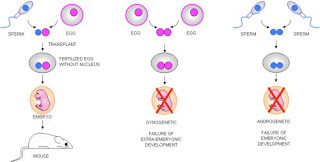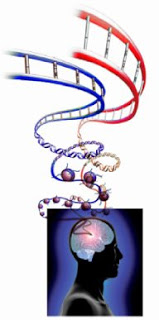Genomic imprinting is one of the most provocative and exciting fields of research falling under the umbrella of “epigenetics”.Imprinting is thought to be a rare, but extraordinarily important mode of gene regulation in the genome and is the primary focus of my research.For this post, I am putting up an excerpt from Brady Weissbourd’s undergraduate thesis. Brady is an outstanding undergraduate here at Harvard who has worked with me for the past year and presents a concise and interesting introduction to the imprinting field in his thesis. I hope you find it informative. Thanks Brady!!
The Discovery of Imprinting
A set of experiments in the 1980’s challenged traditional views of genetics, rewriting Mendelian paradigms and launching the field of genomic imprinting. Despite the expectation that genes are ignorant of their inheritance, it was shown by McGrath and Solter (1984), as well as Surani et al (1984), that both maternally and paternally inherited alleles are required for normal development. Surani et al (1984) demonstrated this phenomenon by making heterozygous and uniparental embryos via nuclear transplantation by adding either a maternal or paternal pronucleus to haploid parthenogenic (unfertilized) embryos. If a paternal pronucleus was added, embryos were able to develop to term. However, eggs with two maternal pronuclei showed embryonic growth, but failed to develop extraembryonic tissues and trophoblast, and survived no longer than the 25-somite stage, roughly ten days after conception (Surani et al, 1984).

This demonstrated that a paternally inherited genome is essential for the development of extraembryonic tissue. Further, embryos created with two paternal pronuclei showed that maternally derived genes are essential for the development of the embryo: androgenetic embryos developed an almost normal trophoblast, but the embryo proper was severely retarded (McGrath and Solter, 1984; Solter, 1988; Surani et al, 1984). Interestingly, human androgenetic cells can develop into hydatidiform moles, characterized by extensive overgrowth of extraembryonic tissues, but generally devoid of an embryo (Bagshawe and Lawler, 1982).
Further studies by Cattanach (1986) and Cattanach and Kirk (1985) of uniparental disomy in mice demonstrated that different phenotypes result from the loss of the maternally versus paternally inherited allele at a single locus. For example, Cattanach and Kirk (1985) showed that within the same litter, a paternal duplication on chromosome 11 lead to large pups, while a maternal duplication at the same locus lead to small pups. Large and small pups for paternal and maternal duplications respectively were also observed for the distal region of chromosome 2. Further, disomies on chromosomes 2, 6, 7, and 8 were shown to result in pre-natal lethality (Cattanach, 1986). Interestingly, maternal disomy 6 is lethal, while paternal disomy 6 is normal (Cattanach and Kirk, 1985; Searle and Beechey, 1985).
These mysterious findings have opened new avenues of research and generated major breakthroughs in the study of genetic inheritance. Indeed, in the last twenty years it has been shown that a subset of genes carry “imprints” of their parent of origin, and are differentially expressed depending on whether they were inherited from the mother or the father (Wilkins and Haig, 2003). These imprints are of epigenetic origin, meaning that the observed heritable differences do not reflect differences in DNA sequence but rather a specific regulatory mechanism, most often in the form of histone modification, DNA methylation, and binding of non-coding RNAs (Tang and Ho, 2007).
Imprinting is a phenomenon hitherto observed only in plants, marsupials and placental mammals (therians) (Haig and Trivers, 1995). This taxonomic distribution suggests that it specifically evolved in tandem with changing parent-offspring relationships (Reik, 2001). The exception to this observation is found in viviparous scale insects and sciarid flies, in which only the maternal chromosomes are present in sperm, as the maternal genome eliminates the paternal contribution during spermatogenesis (Haig, 1992; Haig, 1993; Haig and Trivers, 1995).
The discovery of imprinting has provoked exciting new experimental research and theoretical considerations, providing profound insight into the elegance of evolution and the intricacies of mammalian cognition and behavior.
Brandon Weissbourd, Harvard Honors Thesis, 2009

